First World War
How to use this guide
The Alexander Turnbull Library and the National Library of New Zealand have significant collections relating to all aspects of New Zealand and New Zealanders during the First World War.
Use this guide to get research advice, links to information and examples of material that will help you understand our collections, and find and use our First World War resources, with a special emphasis on online resources. We’ll also show you where to go for important historical material that we don’t hold.
We have developed more guides that go deeper into aspects of the First World War, including conscientious objection and medical services.
Getting started with your research

World War I New Zealand soldiers with a copy of 'New Zealand at the Front', 1917. Ref: 1/2-012980-G.
If you’re interested in quick access to digitised material in our collection that relates to the First World War, we have a selection of war diaries and letters that have been digitised and a large collection of photographs from the RSA. However, this is only the tip of the iceberg!
What was the war called?
The multi-lateral war of 1914-1918 has had several different names, and knowing them can help your research, especially with finding older (contemporaneous) resources.
At the time they called it ‘The Great War’, or ‘The World War’, and in the United States of America it was known as the European War. Since then, it has been known as the First World War, World War 1 or I (using a numeral one or a capital i), WW1 or WWI.
The Library of Congress subject heading – which we use as well – is World War 1914-1918. Our suggestion is that you try a variety of these terms when you’re searching, but ‘world war’ is always a good place to start.
What have other people written about my research topic?
You can go straight for primary resources – diaries, letters, photographs, archives – but if you read what other people have written first, you’ll find it easier to locate and understand primary resources. Taken out of context or without any background knowledge, primary sources can be dense and difficult to understand.
The information that you get from secondary resources and the advice in this guide will make it easier for you to use primary resources in your research.
How much raw material do I want to use?
We hold enormous heritage collections, and piles of existing research on the war, containing different experiences and perspectives. If you haven’t narrowed your focus down to a person, time, or topic yet, now’s a good time.
You’ll save yourself a lot of time and effort, especially because working with raw textual material, like diaries and government archives, can take much longer than you’d think.
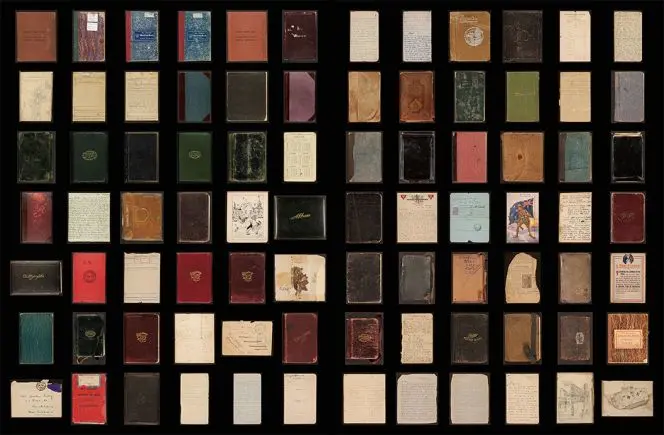
Diaries from the First World War. Photo by Ish Doney.
What issues do I need to consider when using what I find?
Understanding copyright and attribution are key skills for any researcher. The Copyright Council has a lot of useful guidance that you should be familiar with when reusing material, particularly when publishing.
We also provide an attribution statement on every item’s page on this website, which includes all the information you need to reference it well. For example:

Useful shortcuts
The First World War Centenary programme (WW100) has an excellent guide to help you find significant First World War research collections around the country.
NZHistory covers a large range of topics about New Zealand during wartime. Use their excellent resources to help you get started with your research:
A list of excellent books about New Zealand's First World War experience
Comprehensive coverage about New Zealand and the First World War, including research advice.
Subject headings
Subject headings, which we also call authorities, help you find good quality results that have been grouped together by experts. An item will often have a number of headings attached to it, making them a good way to move from one part of the collections to another.
Published and unpublished collections usually use separate, but similar, subject headings. For example, a lot of unpublished material, like diaries or photographs, can be found under the subject heading ’World War 1914-1918’ and published collections (like books) under a similar heading. And even both of those don’t include anywhere near everything we have relating to the war.
Subject headings can get very specific, and will be very helpful as you narrow down your topic. See all the subject headings that come under ‘World War, 1914-1918’.
The following subject headings bring together large amounts of First World War related material:
A ‘Campaign’ represents the overall strategic objective or objectives that may be achieved through a number of battles and military operations. If you are concentrating on events in a certain place or time, the subject headings relating to campaigns and battles can be useful, for example:
Similarly, major battles often have their own headings, for example:
As do particular units:
Researching with images
Rich visual depictions of the First World War can be found in photograph albums, sketchbooks, newspapers, illustrated magazines, letters, diaries, maps, cartoons and caricatures and studio portraits. Using them, you’ll find the official and unofficial visual records of the war.
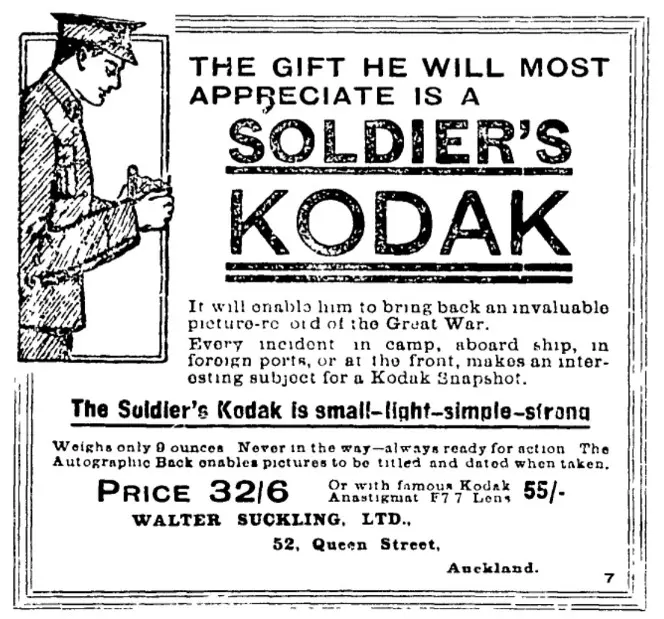
Advertisement for Soldier's Kodak camera. Auckland Star, 20 September 1915.
Advances in photographic technology meant that the First World War was the first war to be widely photographed by its participants. From 1898 the company Eastman Kodak had introduced easy to operate portable, inexpensive cameras and film developing processes that were aimed at the mass consumer market. Defying orders not to take cameras to war, many soldiers and nurses created evocative records of life in the camps, hospitals and battlefields.
The bird’s eye view possible from an aeroplane meant that military on all sides increasingly relied on intelligence from aerial reconnaissance. Development of the Thornton Pickard aerial camera in 1915 and the Eastman Kodak aerial cameras used by United States Signal Corps in 1917 meant that map sketches and verbal reports were increasingly replaced by aerial photographs.
Useful books
Sandy Callister, The Face of War: New Zealand's Great War Photography, 2008
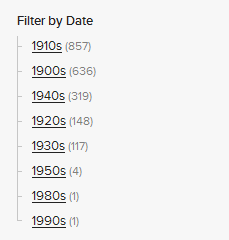
Searching for images
It can be challenging to narrow the many images down to images of specific events, people, and activities. When you’re searching, try keywords such as world war and then your specific subject such as Gallipoli, tanks, soldiers, Somme, food etc. For example, world war rations.
Getting too many results from the Second World War? Use the date filters on the left of the results page to limit your results to the 1910s. Not all images have firm dates, but this technique will remove the 1940s from your results.
Looking for a specific soldier?
Most individual soldiers have not been identified in our images. Where we do know the name or names of a soldier, this information has been added to the record so you can search by the name. If you can’t find your soldier by name, you could find out where they went (and when) and browse through the images to see if you can identify them in any of the photographs.
You may also find them by using the subject heading for their unit, and browsing through the images there.
Non-digital images
Only a small percentage of our images are available online. If an image’s record page doesn’t show the picture, you’ll need to come into the Library reading rooms to view the album or negatives, or contact the Library to send you a scan or description. If you’re planning a visit to the Library to see heritage materials like this, it’s always a good idea to let us know in advance so that we can get the material ready for you.
To see the physical photographic prints, come to Alexander Turnbull Library Reading Rooms, on level one of our Wellington building.
Photographic Collections relating to the First World War
These collections have been selected to give you direct access to our most significant photographic collections relating to the First World War. They also demonstrate the variety of images available.
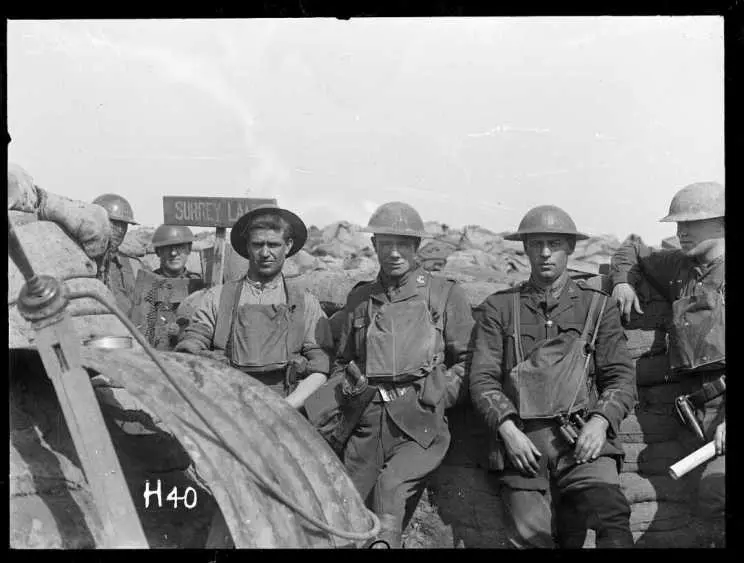
New Zealand officers in the trenches, May 1917. Ref: 1/4-009462-G.
Royal New Zealand Returned and Services Association New Zealand Official Negatives World War 1914-1918
1828 negatives and four albums by official photographers Henry Armytage Sanders and Thomas Frederick Scales showing New Zealand forces in France, Belgium, British Isles, and Egypt. 1595 images are digitised.
The First World War albums
14 albums of official New Zealand First World War photographs taken by Henry Armytage Sanders, the Royal Air Force and unknown photographers during 1917-1918. Images show the NZEF in France and Belgium, tank warfare, Royal Flying Corps and other aviation service scenes, medical services, sport and recreation, views of the Western Front and Battle of Messines. Includes the Ramleh War Cemetery and Jerusalem War Cemetery 1927. Some images from these albums have been digitised.
The World War 1914-1918 Official H series Z1/6
One album of official NZ army photographs of the NZEF in France and Belgium taken by Henry Armytage Sanders 1917-1918. This album has not yet been digitised.
Photographs by Malcolm Ross of New Zealanders in the Great War, Maori, mountaineering, New Zealand scenery
Includes images of the arrival of the New Zealand Expeditionary Force to Samoa in 1914. 82 images have been digitised.
Copy of a album containing photographs of some specimens of plastio facio-maxillary cases of the New Zealand section, Queen's Hospital, Sidcup, Kent, England
A copy of one album showing New Zealand soldiers with facial reconstructions performed by the New Zealand section at Queens Hospital, Kent, England circa 1918. This album has not been digitised.
Photographs of Agnes Elizabeth Lloyd Bennett 1900-1936
Collection focuses on Agnes Bennett’s medical career during the First World War including her work at a military hospital in Egypt 1915-1916, her command of the No 7 Unit of the Scottish Women’s Hospitals for Foreign Service attached to the Serbian Army 1916-1917, and her work at a British military hospital and on troop ships in 1918. Nine images from the collection have been digitised.
A soldier’s experience of the Gallipoli campaign April to September 1915
Three albums of photographs compiled by George Gordon Denniston showing the life of a soldier leaving for war, the ocean voyage, camp life in Egypt and the Gallipoli campaign April to September 1915. One album features copies of official WW1 photos 1917-1918 taken by Sanders. 93 of these images have been digitised.
Artists who created images of the First World War
Sketches and other artworks were an important way that participants documented their war experience and the experience of those around them. Most soldier’s diaries or letters include a sketch or two. These established artists created a body of work that incorporates a wide variety of perspectives on the First World War.
James O’Grady
Corporal James O’Grady was in the Otago Infantry Regiment, E Company. We hold two sketchbooks (reference: E-919/920) of over 100 sketches of trench warfare and effects of war from the point of view of a New Zealand soldier in Belgium 1918-1919. These sketches are available online.
Francis Ledingham McFarlane
McFarlane drew sketches and cartoons during service in Iraq, Iran, Egypt, Palestine while serving with Australian and New Zealand Mounted Division.
Nugent Herrmann Welch
Welch was an artist who enlisted in March 1916. He was later to become a well known New Zealand landscape artist.
We hold a Welch sketchbook of watercolours and pencil drawings of WW1 scenes (Reference: E-940), showing leaving Fremantle, the Indian Ocean, Dakar in West Africa, Salisbury, England, Bapaume, France, the ship journey home through the Panama Canal, and scenes finally back in New Zealand. Many of the sketches are available online. We also hold some of his watercolours.
As Welch was an official war artist, many of his works are held at Archives New Zealand.
Horace Millichamp Moore-Jones
Horace Millichamp Moore-Jones was an artist and sapper with the NZ Engineers at Gallipoli. We have a small collection of his works.

Horace Millichamp Moore-Jones, Anzac Cove; the historic landing-place, 1915. Ref: A-184-058.
Arthur John Lloyd
Lloyd was originally a Londoner. He spent three and a half years fighting with the NZ Expeditionary Force in the First World War, returning to New Zealand to live after the war. We hold two of his works.
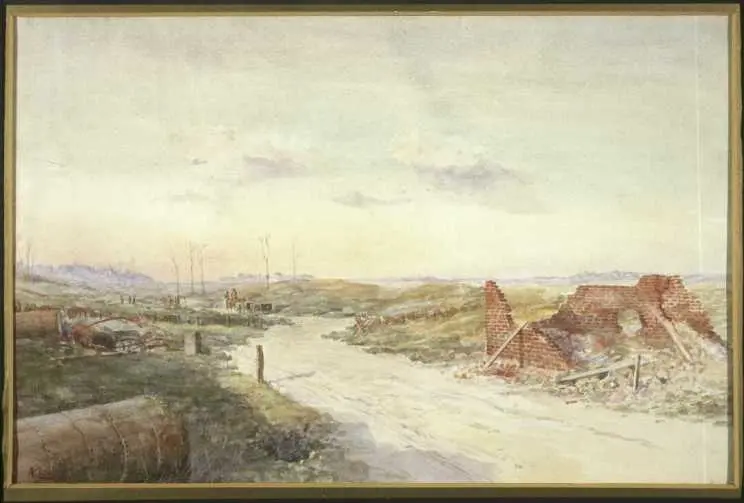
Arthur John Lloyd, War-time desolation, ca 1916. Ref: A-176-028
William Frederick Bell
Bell was a New Zealand artist and cartoonist who served in the New Zealand Rifle Brigade in France. His caricatures of soldiers’ life in the trenches in France were published in the magazine Shell shocks.
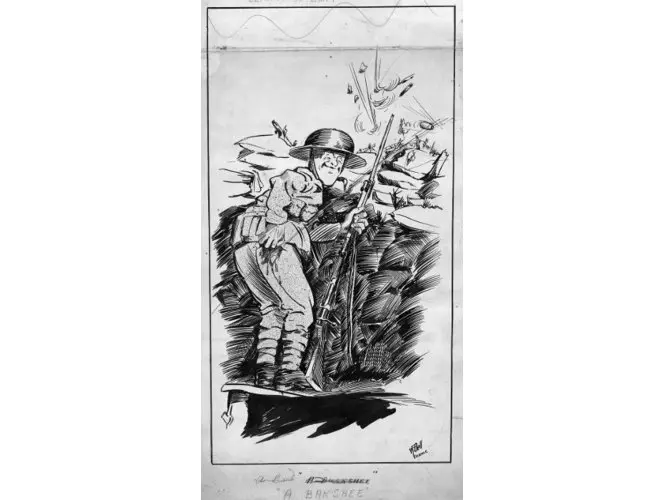
William Frederick Bell, "A bakshee. Blighty at last!" 1916. Ref: A-222-011.
George Edmund Butler
Butler was an official war artist, and there is a large collection of his works at Archives New Zealand.
Books and serials
You can search for books about First World War through the National Library of New Zealand catalogue. They are available to registered readers in the Alexander Turnbull Library Reading Room or offsite through your local library if they have a copy. You may also be able to get it through interlibrary loan.
How to register to use the Reading Room
We have a lot of books on the New Zealand experience of the war, personal accounts, and particular parts of the war, as well as fascinating serials such as troopship magazines.
Books containing personal accounts of the First World War
Personal accounts that have been published as books or in books are an easily accessible way to start looking into first-hand accounts of wartime experiences.

World War I New Zealand soldiers with a copy of 'New Zealand at the Front', 1917. Ref: 1/2-012980-G.
Good subject headings for personal accounts published in books include:
Some particularly interesting titles, some of which contain a lot of material from manuscripts in the Alexander Turnbull Library, include:
Jock Phillips, Nicolas Boyack and E P Malone (Eds.), The Great Adventure: New Zealand soldiers describe the First World War, 1988
Jane Tolerton (Ed.), An awfully big adventure: New Zealand First World War veterans tell their stories, 2013
Glyn Harper, Letters from the battlefield: New Zealand soldiers write home, 1914-1918, 2001
Nicholas Boyack and Jane Tolerton, In the shadow of war: New Zealand soldiers talk about First World War and their lives, 1990
E G Pilling, An Anzac memory: extracts from the rough diary of Lieutenant E G Pilling, 1933
A C Aitken, Gallipoli to the Somme: recollections of a New Zealand infantryman, 1963
Rikihana Carkeek, Home little Maori home: a memoir of the Maori Contingent, 1914-1916, c2003
John Crawford (Ed.), The devil’s own war: the First World War diary of Brigadier-General Herbert Hart, 2008
Jock Vennell, The forgotten general: New Zealand’s World War I commander, Major-General Sir Andrew Russell, 2011
Gallipoli
John Crawford and Peter Cooke (Eds.), No better death: the Great War diaries and letters of William G Malone, 2005
Cecil Malthus, Anzac: a retrospect, 1965
Anzac, On the Anzac trail: being extracts from the diary of a New Zealand sapper, 1916
Clutha N Mackenzie, The tale of a trooper, 1921
Colin Townsend, Gallipoli 1915: tribute to those who were there, 1999
Jonathan King and Michael Bowers, Gallipoli: untold stories from war correspondent Charles Bean and front-line Anzacs: a 90th anniversary tribute, 2005
Western Front
Cecil Malthus, Armentieres and the Somme, c2002
Andrew Macdonald, On my way to the Somme: New Zealanders and the bloody offensive of 1916, 2005
Glyn Harper, Massacre at Passchendaele: the New Zealand story, 2000
N M Ingram, Anzac diary: a nonentity in khaki, 1987
Bill Malcolm, Boots, belts, rifle and pack: a New Zealand soldier at war, 1917-1919, edited and compiled by Dorothy McKenzie and Lindsay Malcolm, 1992
Allan Marriott, Mud beneath my boots: a poignant memoir of the effects of war on a young New Zealander, 2005
C A L Treadwell, Recollections of an amateur soldier, 1936
Naval
Grant Howard, ‘Gunner Billy’: Lieutenant-Commander W E Sanders VC, DSO, RNR, 2007
Medical
See our Medical Services guide to the First World War.
Peter Rees, The other Anzacs: nurses at war, 1914-1918, 2008
John Meredith Smith, Cloud over Marquette: the epic story of those who sailed in the ill-fated troopship Marquette, c1990
R Campbell Begg, Surgery on trestles: a saga of suffering and triumph, c1967
Arthur Anderson Martin, A surgeon in khaki, 1915
Conscientious objection
See our research guide on Conscientious objection.
Archibald Baxter, We will not cease, 1939
Wartime Reporting – Newspapers and Magazines
The largest set of collection material available online is Papers Past, the site for fully searchable historic newspapers. The site covers large and small newspapers around the country.
To search for reporting of the First World War on Papers Past, you can narrow your search by date, for example 1913-1925. Other search suggestions in this guide will also be useful for searching in newspapers.
You can use Australian and New Zealand newspapers to detect patterns of language and reporting over the wartime period using QueryPic, created by Tim Sherratt. For example, see the changing usage of “the great war”, “first world war”, and “world war I”.
Troopship magazines
During the First World War soldiers aboard troopships en route to war and back sometimes published magazines. They were intended to be informative, entertaining and to help the morale of soldiers. They contain articles, poems, songs, humour, caricatures and other material, depending on the available skills of soldiers onboard.
We hold a handy list of our troopship magazines compiled by John Studholme – a copy of it is available in the Alexander Turnbull Library Reading Room.
Dunedin Public Libraries and the Auckland War Memorial Museum Library also hold significant collections of these magazines.
Some of the troopship magazines held in the Alexander Turnbull Library are:
H.T.B Drew, and H.W.L. Digby (eds.), The moa: being the literary pickings of a troopship, 1917?
Kit-bag: the unofficial record of the following units of the Fourteenth Reinforcements on board the "Maunganui", Troopship 56, 1916
E.G. Pilling and J.G. McGhie and R.B. Bell, Pakeha: the journal of the Seventeenth Reinforcements of the New Zealand Expeditionary Forces aboard H.M.N.Z. Transport 65 (S.S. Pakeha), 1916
Hohipera journal, 1916-
Orari tatler: a souvenir of the voyage of the New Zealand Expeditionary Force from Wellington to Alexandria, 1915
Straggler's echo: an unreliable record of the 26th Reinforcements on board H.M. Troopship.
Manuscripts
The Alexander Turnbull Library holds a very large collection of wartime letters and diaries. They contain the direct reported experiences of those involved in the war.
A comprehensive set of online letters, diaries, and journals (and some maps) relating to First World War can be found under the search term WW100 Digitisation Project. Read a blog explaining this project.
Digitised manuscripts
You’ll find the following kind of material in the digitised manuscripts:
George Wallace Bollinger
Second Lieutenant George Bollinger served New Zealand in the Egypt and Gallipoli campaigns, with the Hawkes Bay Company of the Wellington Infantry Regiment. His diary (reference: MS-Papers-1419) begins on 11 Aug 1915. We also have a collection of his letters home (reference: MS-Papers-2350).
Clyde McGilp
Having served in the Boer War, as well as First World War, Clyde McGilp’s historical records and war diary (reference: MS-1772) contain detailed accounts of the landing at Gallipoli and of taking Chunuk Bair on 8 Aug 1915. Returning from service in Egypt and France, Major McGilp died of influenza in 1918 at the Featherston Military Camp.
Henry Kitson
Henry Kitson left New Zealand in February 1915 aboard the Tahiti, he saw action in the Gallipoli Campaign with the 1st Canterbury Regiment before being injured in June 1915 and transported, first to Floriana Hospital in Malta, then to various military hospitals in England including Woodcote Camp in Epsom, Hyde Park Hospital in Plymouth and Walton on Thames. He was discharged from hospital in February 1917 and joined the 37th Reinforcement in 1918, he served as a Warrant Officer at the battles of Bapaume, Biefrillers, Cambrai and Le Quesnoy. His letters home and diary have been digitised. His daughter-in-law Helen transcribed this collection, which provides an easier way of skimming this material if you’re looking for a specific event or name.
A long time researcher at the Alexander Turnbull Library, Robert (Bob) Cameron, has transcribed many of the First World War memoirs, diaries and letters in our collection which makes them more accessible for people who aren’t able to come to the Library. The transcripts are available on his Wordpress website.
Manuscripts not available online
A large amount of material in this collection has not been digitised yet. Most collection items are described on our website, and on the Tiaki catalogue of unpublished material. Manuscripts can be viewed in the Library’s Katherine Mansfield reading room. You need to be registered as a reader to use collections in this room.
Some manuscripts are also on microfilm, and can be interloaned through local libraries with a microfilm reader. Some copying of manuscripts for research is available through our Ask a librarian service.
Tiaki provides several ways to search and browse. Try the following terms to find First World War manuscripts:
Subject searches
Soldiers-diaries (refine by date to 1914-1918)
Soldiers-Correspondence (refine as above)
World War, 1914-1918 – Campaigns – Turkey – Gallipoli Peninsula
World War, 1914-1918 – Campaigns – France
World War, 1914-1918 – Campaigns - Belgium
Record type searches
Personal Records Diaries (refine by date to 1914-1918)
Personal Records Correspondence (refine as above)
Broad (keyword) searches
Flers
Armentieres
Ypres
Restrictions and permissions
We restrict access to some manuscripts for preservation reasons or due to donor agreements.
If a restriction exists, you will see it on the record page, either under ‘issue restriction’ on Tiaki, or ‘DC Rights’ on this site.
Talk to staff about how you may gain permission to view the item, and we’ll do what we can to help you. You may want to drop us a line through Ask a Librarian before you come in.
Oral history interviews
Oral History provides the opportunity for you to directly access the voices of the past – not just the people in power, but the everyday people who otherwise might not be represented in the historic record. In the Alexander Turnbull Library’s oral history and sound collection, soldiers and nurses tell the story of their unique war experience in their own words.
To find oral history interviews you can search these onsite at the Alexander Turnbull Library, or ask a librarian to do this for you. We’re currently working on providing more online access to this material.
If you want to listen to oral history material or use recordings or quotes from oral histories as part of your research, you will need to allow for a significant amount of time. This is for two reasons. You need to get permission to access and use most interviews in our collection – the Library staff can help you with this – and we also need to make an access copy of the recording, to avoid damaging the original.
Significant Oral History collections relating to the First World War
Please contact the Alexander Turnbull Library if you want to listen to these recordings.
World War I Oral History Archive
OHColl-0006
This archive includes 84 interviews with First World War New Zealand veterans conducted in 1988-1989 by Jane Tolerton and Nicholas Boyack. These cover the veterans’ early lives, training in New Zealand, overseas service and locations, including Gallipoli, the Somme, Passchendaele and Palestine, returning to New Zealand and activities after the war.
Nursing Education and Research Foundation oral history project
OHColl-0014
This project includes interviews with the following nurses who were active in the First World War: Emily Hodges, Amy Copeland, Mary Clarke, Sophia Reyburn, Winifred Spencer, Charlotte McIntyre, Ivy Muggeridge, Charlotte Le Gallais, Florence Le Lievre and Emily Collingwood.
NZOHA Martinborough Project
OHColl-0005 36
These interviews were recorded in 1981-1982 by Judith Fyfe and Hugo Manson. Many of the interviewees talk about the1918 flu epidemic and other aspects of the war.
Interview with George H Lee
OHColl-0177/1
George Lee was interviewed about the First World War in 1981 by Jack Perkins.
Interview with Frederick Charles Bettjeman
OHInt-0004/09
Mr Bettjeman was interviewed in 1985 as part of the NZOHA Sunlight Centenarians Oral History Project. He describes his wartime experience in depth and discusses his experience of land rehabilitation after the war. This interview is an example of one of the many with First World War content which are in projects not directly related to the First World War, or in life history interviews.
Where else can I search for First World War material?
Air Force Museum of New Zealand
Visit the Air Force Museum website
New Zealand had no air force during the First World War but several hundred New Zealanders served with the Royal Flying Corps, the Royal Naval Air Service, the Royal Air Force and the Australian Flying Corps.
The Museum’s Research Collection focuses on aviation history. It contains:
Personal collections and manuscripts
Ephemera
Logbooks
Journals
Technical drawings
Photographs
Archives New Zealand
Aliens (Enemy) during the First World War [AAAC 6519/1; REPRO 1658]
Casualty Rolls
Decorations and Awards
Defaulters, Deserters and Conscientious Objectors
Diaries & Statements [WA 10/3]
Pioneer (Maori) Battalion
Maps
Nominal Embarkation Rolls 1st NZ Expeditionary Force 1914-1919
New Zealand Army Nursing Service
Pensions
Photographs
Rehabilitation of Soldiers after the First World War
Reservist Rolls
Unit Diaries
Auckland Libraries
Visit the Auckland Libraries website
The Sir George Grey Special Collections hold:
Manuscripts (Personal papers and diaries)
Maps (Gallipoli)
Ephemera
Auckland War Memorial Museum
Visit the Auckland War Memorial Museum website
The Armoury Information Centre and the Museum Library hold extensive collections relating to New Zealand service personnel and military organisations. These include:
Weapons, Medals and Decorations – on display in the Armoury Gallery
Cenotaph Database – biographical records of men and women who served in the First World War
Personal diaries and letters of individual servicemen and women
Photographs and photograph albums
Community Archive
Visit the Community Archive website
Formerly known as NRAM (National Register of Archives & Manuscripts), the Community Archive is a hub for New Zealand archival collections from a large range of contributors from individuals, small local organisations to large institutions.
They provide subject areas to help you search, including War, and War Veterans.
Digital New Zealand
Visit the Digital New Zealand website
Search New Zealand online content from a large range of contributors. Search millions of pieces of New Zealand online content from over 150 content partners. You can also view, make, and share sets of topical material.
Hocken Collections
Visit the Hocken Library website
The Hocken Library part of the University of Otago Library holds large collections relating to the First World War. They provide a guide to this material (pdf).
Museum of New Zealand Te Papa Tongarewa
Te Papa’s Library and Archives include:
First World War Ephemera
Battle plans
Correspondence
Berry & Co First World War soldiers portraits
The National Army Museum
Visit the National Army Museum website
The Kippenberger Research Library and Military Archive hold extensive collections that specialise in army history during the First World War:
Personal diaries, memoirs and letters
Records of certain veteran associations
Photographs and photograph albums
Artworks
Oral histories
Newspapers
Troopship and unit magazines
Maps and plans
Ephemera
Philatelic collections
Souvenirs and photocards
Military sheet music
Military training and technical manuals/pamphlets
National Museum of the Royal New Zealand Navy
Visit the National Museum of the Royal New Zealand Navy website
The New Zealand Naval Forces (part of the Royal Navy) have a collection of oral histories relating to the First World War.
Acknowledgements
Thanks to the following team for creating this guide:
Dolores Hoy (Research Librarian, Digital Materials)
Jenni Chrisstoffels (Research Librarian, Pictorial)
Jocelyn Chalmers (Research Librarian, Manuscripts)
Kirsty Cox (Research Librarian, Digital Materials)
Amy Watling (Online Research Services Leader)
And thanks also to the reviewing team:
Janet McFadden (Development Specialist, 21st Century Literacy)
David Colquhoun (Curator Manuscripts)
Dr. Melinda Johnston (Research Librarian, Cartoons)
Reuben Schrader (Web Editor)
Need to know more?
Services to Schools First World War guide
A great guide for teachers and educators.
Where to find our Reading Rooms, and how to make use of them
natlib.govt.nz/visiting/wellington/the-reading-rooms
What to know before you come on in for a visit.
Ask a Librarian
If you can’t make it in to the Library, need to ask a question, or want help with accessing collections, send us an enquiry.
The main WW100 website
Central home for New Zealand's centenary activities.